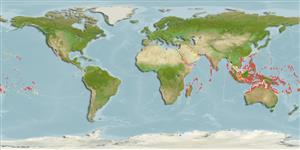Environment: milieu / climate zone / depth range / distribution range
экология
морской ассоциированный с рифами; пределы глубины 1 - 30 m (Ref. 1602). Tropical; 30°N - 28°S
Eastern Indian Ocean: although reported to occur widely in the Indo-Pacific, specimens have only been collected at the Batu Islands, off Sumatra, Indonesia. Western Indian Ocean: Gravid females have been collected from Seychelles Islands (Ref. 45699).
Length at first maturity / Size / Вес / Возраст
Maturity: Lm 4.8, range 5 - 5 cm
Max length : 12.0 cm SL самец/пол неопределен; (Ref. 1602)
колючие лучи спинного плавника (общее число): 0; членистые (мягкие) лучи спинного плавника (общее число): 75-88; колючие лучи анального плавника 0; членистые (мягкие) лучи анального плавника: 59 - 69; позвонки: 41 - 45.
Rare species (Ref. 34024) notable for its strict association with true reef environments and particularly so with outer reefs and reef cores (Ref. 81230). An indweller of deep interstices of lagoon and seaward reefs to a depth of at least 30 m (Ref. 1602). Ovoviviparous (Ref. 240). Solitary inhabitant of shallow water, cryptic (Ref 90102).
Ovoviviparous. Sexes can be readily distinguished by the male's intromittent organ and the female's genital pore (Ref. 240, 205). On the basis of this morphology, copulation may involve flexion of the male's body and pumping of sperm into the female (Ref. 240). Embryos are retained in the ovaries until about 6 mm long, deriving nourishment from large yolk sacs, making the species ovoviviparous rather than viviparous (Ref. 240).
Nielsen, J.G., D.M. Cohen, D.F. Markle and C.R. Robins, 1999. Ophidiiform fishes of the world (Order Ophidiiformes). An annotated and illustrated catalogue of pearlfishes, cusk-eels, brotulas and other ophidiiform fishes known to date. FAO Fish. Synop. 125(18):178p. Rome: FAO. (Ref. 34024)
Статус Красного Списка МСОП (Ref. 130435)
Угроза для людей
Harmless
Использование человеком
дополнительная информация
ссылкиаквакультура (рыбоводство)особенности рыбоводствастепень растяжениягенетикаElectrophoresesнаследуемостьболезниобработкаNutrientsMass conversion
инструменты
Специальные отчеты
Скачать в формате XML
ресурсы в Интернет
Estimates based on models
Preferred temperature (Ref.
123201): 25.5 - 29.3, mean 28.4 °C (based on 3018 cells).
Phylogenetic diversity index (Ref.
82804): PD
50 = 0.7500 [Uniqueness, from 0.5 = low to 2.0 = high].
Bayesian length-weight: a=0.00389 (0.00180 - 0.00842), b=3.12 (2.94 - 3.30), in cm total length, based on all LWR estimates for this body shape (Ref.
93245).
Trophic level (Ref.
69278): 2.6 ±0.1 se; based on diet studies.
Fishing Vulnerability (Ref.
59153): Low vulnerability (10 of 100).
Nutrients (Ref.
124155): Calcium = 138 [75, 245] mg/100g; Iron = 0.922 [0.534, 1.561] mg/100g; Protein = 16.9 [14.3, 19.3] %; Omega3 = 0.11 [0.06, 0.19] g/100g; Selenium = 32.5 [16.6, 73.1] μg/100g; VitaminA = 88.1 [26.6, 286.7] μg/100g; Zinc = 2.24 [1.53, 3.13] mg/100g (wet weight);
